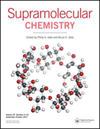A colorimetric and fluorescence sensor based on biphenolic-dansyl derivative for specific fluoride ion detection
IF 2.6
4区 化学
Q3 CHEMISTRY, MULTIDISCIPLINARY
引用次数: 1
Abstract
ABSTRACT 2ʹ-(2-((4-(methylthio)phenyl)amino)-2-oxoethoxy)-[1,1ʹ-biphenyl]-2-yl 5(dimethyl amino)naphthalene-1-sulphonate (1) was synthesised and used as a F− ion sensor. The selectivity of sensor 1 with various anions (F−, Cl−, Br−, CH3COO−, C6H5COO− and H2PO4 −) in DMSO was evaluated by 1H NMR, UV-visible and fluorescence study. For 1H NMR, an amide proton of sensor 1 disappeared due to the deprotonation reaction upon addition of F− ion. On the contrary, the proton signal of HF2 − emerged at 16.11 ppm. Upon addition of F− ion, sensor 1 showed a new absorption band at 300 nm and the solution turned colourless. For fluorescence response, sensor 1 exhibited the enhancement of emission intensity at 434 nm with slight blue shift when titrated with F− ion. These results suggest that sensor 1 possessed high sensitivity and selectivity towards F− ion detection. In addition, the sensor 1 test strip coated on TLC plates and filter papers were demonstrated for specific detection F− ion. Graphical abstract一种基于双酚丹酰衍生物的氟离子特异性检测比色和荧光传感器
摘要合成了2′-(2-(4-(甲基硫)苯基)氨基)-2-氧乙氧基)-[1,1′-联苯]-2-基5(二甲基氨基)萘-1-磺酸盐(1),并将其用作F -离子传感器。通过1H NMR、紫外可见和荧光研究,评价了传感器1对不同阴离子(F−、Cl−、Br−、CH3COO−、C6H5COO−和H2PO4−)在DMSO中的选择性。在1H NMR中,传感器1的一个酰胺质子在加入F−离子后发生去质子化反应而消失。相反,HF2−的质子信号在16.11 ppm时出现。加入F−离子后,传感器1在300 nm处显示出新的吸收带,溶液变为无色。在荧光响应方面,传感器1在434 nm处的发射强度增强,并伴有轻微的蓝移。这些结果表明,传感器1对氟离子检测具有较高的灵敏度和选择性。此外,还演示了涂覆在TLC板和滤纸上的传感器1测试条对F−离子的特异性检测。图形抽象
本文章由计算机程序翻译,如有差异,请以英文原文为准。
求助全文
约1分钟内获得全文
求助全文
来源期刊

Supramolecular Chemistry
化学-化学综合
CiteScore
3.60
自引率
3.00%
发文量
5
审稿时长
2.7 months
期刊介绍:
Supramolecular Chemistry welcomes manuscripts from the fields and sub-disciplines related to supramolecular chemistry and non-covalent interactions. From host-guest chemistry, self-assembly and systems chemistry, through materials chemistry and biochemical systems, we interpret supramolecular chemistry in the broadest possible sense. Interdisciplinary manuscripts are particularly encouraged. Manuscript types include: high priority communications; full papers; reviews, and; Methods papers, techniques tutorials highlighting procedures and technologies that are important to the field. We aim to publish papers in a timely fashion and as soon as a paper has been accepted and typeset it will be published in electronic form on the Latest articles section of the website. The two most important review criteria are that the paper presents high-quality work that fits generally into the broad spectrum of activities in the supramolecular chemistry field. Under normal circumstances, Supramolecular Chemistry does not consider manuscripts that would be more suitable in a highly specialized journal. This includes, but is not limited to, those based mostly or exclusively on topics such as solid state/X-ray structures, computational chemistry, or electrochemistry. .
The two most important review criteria are that the paper presents high-quality work that fits generally into the broad spectrum of activities in the supramolecular chemistry field.
 求助内容:
求助内容: 应助结果提醒方式:
应助结果提醒方式:


